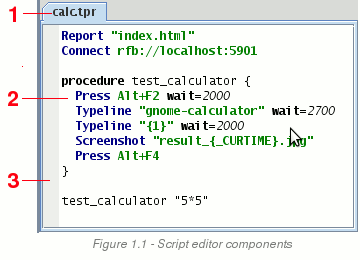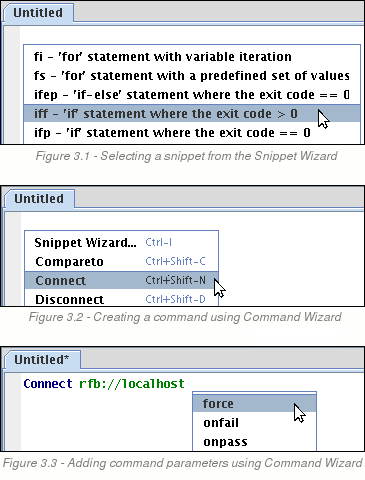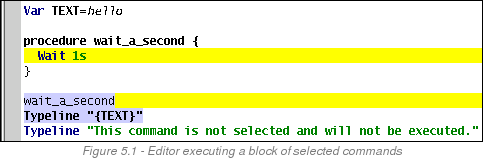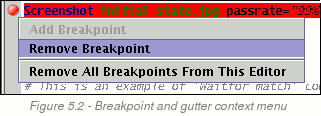T-Plan Robot Enterprise 2.3.5 Script Editor
Contents
1. Script
Editor Overview
2. Editor Context Menu
3. Writing Test Scripts
4. Compiling Test Scripts
5. Executing Test Scripts
1. Script Editor Overview
Script editor allows to create and edit test scripts. It is a
standard text editor with additional features designed to facilitate
easy writing and execution of test scripts. Editors are
organized in a tabbed pane in the left bottom part of the GUI. Each
editor consist of three main components:

- Enclosing tabbed pane
serves as editor container. Tab name is always set to the script file
name. If the editor content has been modified, an asterisk gets
appended to the name. If the editor content hasn't been saved to a file
yet, the tab text is set "Untitled". When you hover your mouse pointer
over the tab text, it displays a tool tip message with full script file
path. The tab also provides a context menu on a right mouse click with
a
selection of actions available in the main GUI File menu, such
"Save Test Script", "Close Test Script" etc.
- Text
editor is a standard text editor with all usual editing
functionality, such as undo/redo, cut/copy/paste, search/replace and go
to line. Most of these features are available both in the Edit menu of
the main GUI or through the standard hot keys, such as Ctrl+C for
copying etc. Additional application specific features supported by the
editor are:
- Syntax
Highlighting
improves readability of the code and helps to distinguish individual
elements of the scripting language. The color scheme can be customized
in the Script Editor panel
of the Preferences window. This
functionality does not apply to Java test scripts.
- Editor
Context Menu allows access to selected actions of the script as
well as
of a particular script element, such as a command. See the Editor Context
Menu chapter for details.
- Command
and Snippet Wizards provide a comfortable GUI assisted way to
create scripting language commands or even fragments of code
(snippets). See the Writing Test Scripts
chapter for details.
This
functionality does not apply to Java test scripts.
- Script
Execution Support features allow to control and debug execution
of the test script. As the editor closely cooperates with the
underlying test script interpret, it allows to restrict execution just
to a subset of commands, trace the execution progress, set up and
activate break points or even enter into a mode where just one command
is executed at a time (Step Execution). See the Compiling
and Executing Test Scripts
chapters for details. Most of this
functionality however does not apply to Java test scripts.
- Editor
gutter allows to define break points to suspend (pause) script
execution at. This functionality applies mainly to test scripts in the
proprietary scripting language. Support of break points in Java test
scripts is very limited.
2. Editor Context Menu
The context menu is accessible through a right mouse click onto a text
line of the text editor component:

The menu contains three types of actions:
- Stable
editor actions
such as Compile Script and Configure Editor. These are always
available, usually at the bottom of the menu.
- Context
actions are associated with the text element on the line near
the mouse click location. If the line is empty, the editor provides
access to the Command and Snippet Wizards. If the line
contains a valid command, the menu usually contains actions allowing to
open the command specification (Help
on <command>). Configurable commands also allow to open
their preferences through the Configure
<command> menu item. All these actions are created into
the menu by the editor.
- Command
specific actions are inserted directly by the individual command
handlers. These are either static or dynamic items which are available
only
under specific conditions. The Display
Supported Keys action on the picture above is example of a
static action and it is always available when the menu is open in
context of the Press command. The Continue
action of the Wait command is on the other hand a dynamic item. As it
allows to skip the remaining timeout and resume the execution
immediately, it is available only when the command is being executed.
The menu can be also activated by pressing Ctrl+Shift+Enter. To modify
this shortcut key open the Preferences
window and navigate to Appearance & Accessibility -> Script
Editor.
3. Writing Test Scripts
The editor is equipped to support easy script writing even for
those users who are not fully familiar with the scripting language. The
following work flow is recommended for writing of test scripts:

- Use
script recording to generate basic structure of your script.
See the Script Recorder help topic for
details. This will help you to create a flow of key and mouse events
needed to reproduce a task (test case) on the remote desktop. Then
perform manual adjustments to the generated code - modify timeouts,
merge commands, create reusable procedures or parametrize command
arguments through variables where necessary.
- As you record, define points of verification when
it is
appropriate to verify content of your remote
desktop using image comparison. Stop recording at each such a point and
take advantage of one of the CompareTo, Screenshot or WaitFor
Wizards to save a template image and generate the corresponding
command into the editor. As the commands typically generate a numeric
exit command indicating image comparison success or failure, you will
also need to insert a conditional structure allowing you to handle an
eventual error.
To do so comfortably through the GUI press Ctrl+I in the editor to open the Snippet Wizard (see Figure 3.1).
Snippets are predefined often used code fragments (templates). To
insert a snippet simply select it from the list. Each code template has
a short key which allows quicker selection. To support faster
performance, the wizard filters the
list of snippets based on the text
typed. If you type the first few characters of a template short key
into the editor and open the wizard, it will match the
text against the list and display just snippets with the given prefix.
If you for example
type 'if' and press Ctrl+I,
the wizard will display just the snippets associated with the if
and if/else statements. This filtering is also applied
when the wizard
menu is
already displayed. If the text you type is sufficient to identify a
command,
the wizard inserts it directly into the script without displaying the
menu. To review this feature type for example 'iff' into
the editor and
press Ctrl+I to insert an
'if' statement which tests command failure.
To modify the Snippet Wizard shortcut key (Ctrl+I) open the Preferences
window and navigate to Appearance & Accessibility -> Script
Editor.
- Once the basic automation code is in
place, decide how you want to report
the results. The Tool Panel allows
you to define where to save the report generated from script execution.
To create screen shots insert Screenshot command
instances into appropriate locations of your test script. The Screenshot Wizard is designed to help you
to create the command without having to know the command syntax.
- To create instances of other commands
through GUI use the Command Wizard (see
Figure 3.2). To open it press Ctrl+Enter
in the editor while the caret is set on an empty line. The wizard is
basically
a menu of commands specified by the T-Plan Robot Enterprise
2.3.5 Language Reference. To insert a command with all
required attributes simply select it in the menu.
Just like the Snippet Wizard, the Command Wizard filters the command list based on
the text
typed. If you type the first few characters of a
command name into the editor and open the wizard, it will match the
text against the list and display just commands with the given prefix.
If you for example
type 'ty' and press Ctrl+Enter,
the wizard will display just the Type
and Typeline commands. This filtering is also applied when the wizard
menu is
already displayed. If the text you typed is sufficient to identify a
command,
the wizard inserts it directly into the script without displaying the
menu. To review this feature type for example 'scr' and
press Ctrl+Enter to insert a
Screenshot
command into the script.
Once the editor line contains a valid command, the Command Wizard may
be reopened to add command parameters.
An example of the Connect
command parameters is shown on Figure 3.3. If you select a parameter
from
the list, it will be inserted at the end of the command together with a
hint on what the parameter value should be like. Note that the wizard
does not validate the command in any way. It however doesn't checks
which
parameters the line already contains and filters out those which are
already specified by the command.
To modify the default shortcut key (Ctrl+Enter)
open the Preferences
window and navigate to
Appearance & Accessibility -> Script Editor.
4. Compiling Test Scripts
Each script is compiled before execution and eventually after
modification. This task is performed automatically by an object called test script interpret. Proprietary
test scripts do not really compile because their code is interpreted
and the compilation phase is used to check the script for syntax errors
and dependencies. Java test scripts have to be on the other hand
compiled into byte code using Java compiler javac. If
Java Development Kit (JDK) is used as a runtime for T-Plan Robot Enterprise, the
tool is able to compile the Java code seamlessly in the memory and
execute it without even saving the byte code to a file.
The editor cooperates with the underlying test interpret on compilation
of by supporting:

- On-demand
compilation can be invoked either from the editor context menu or the main GUI Script menu.
- On-the-fly
compilation is invoked with each script modification after a
predefined timeout of idle time. This allows continuous checking of
script's validity as it is being created and/or modified. As
compilation is quite time expensive operation, you may experience
slower performance, especially when working with a large script. To
switch this feature off or modify the time out value open the Preferences
window and navigate to Scripting -> Execution. If you switch it off,
be aware that the editor will not report syntax errors until you either
compile the script manually or execute it.
If the compilation process reveals syntax errors, the editor underlines
the invalid commands in red (see Figure 4.1). The error message
returned by the compiler gets displayed in the status
bar when the caret is placed on the error line. The message is also
visible in form of a tooltip when the mouse pointer hovers above the
invalid command. The underline color is configurable through the
Appearance & Accessibility -> Script Editor panel of the
Preferences
window.
Be aware that it is up to the test script interpret whether it is
possible to execute a script containing errors or not. The interpret of
proprietary scripts allows it and skips commands which contain errors.
This may however lead to script failures. The Java interpret on the
other hand doesn't allow any syntax errors because the code fails to
compile.
5. Executing Test Scripts
Script opened in the active topmost editor can be executed using the
controls in the Script menu of the main
GUI window or their corresponding tool bar buttons. If the test
script is a proprietary one, you may execute
just a block of commands instead of the whole script. To do so
select
(highlight) the lines you want to execute and select the Execute
Selection menu item or tool bar button. Note that the commands do
not have to be
highlighted completely. Even if you select just a single character of
the command, T-Plan Robot Enterprise executes the whole line. The following
picture
shows execution of two selected command lines.

Note two important features of block executions.
- Even if you run just a few selected commands, all
procedures and variables contained in the script will be correctly
defined and they may be referenced in the selected commands.
- Execution of commands which form part of a procedure is not
allowed. If you select part of a script which contains a procedure, all
commands in the procedure body will be skipped. You can however call
that procedure inside the selected block.
Another interesting editor feature is that you can actually edit a proprietary script which is being
executed. If you modify code which hasn't been executed yet,
your changes will be picked up as the execution reaches the changed
code. This is possible because the proprietary test script interpret
uses internally the Document Object Model (DOM) to determine which line
(element) is to be executed next. This feature allows together with
break points and step-by-step execution easy and comfortable debugging
of test scripts.
As you may also see on the picture, the editor highligts the currently executed command
line in yellow (or any other custom color). Depending on your
prefereneces the tool even switches among editors and
scrolls the view to show the executed line. This feature enables
user to trace the currently executed command. Its behavior is
controlled by two flags:
- Open Included Files During Script Execution flag available
in the Scripting -> Execution panel of the Preferences window. When you execute a
script, it might run or include other scripts
using the Run
or Include
commands. This
flag defines whether T-Plan Robot Enterprise should open these nested scripts in a
new
editor as they get executed.
- Follow Execution Trace menu
item and toolbar button. If the item/button is selected,
T-Plan Robot Enterprise
will switch among editors and scroll the editor view to show the
executed line. This flag is by default switched on. If you switch among
editor manually or start to edit
a
script during execution, this feature gets automatically switched off.
Debugging of test scripts is further on supported by Breakpoints and Step By Step Execution capability.
Breakpoints let you stop execution of a script on certain lines. Once a
breakpoint is reached, the script gets paused and won't resume until
you
deselect the Pause menu item or toolbar
button.
To define a breakpoint click
onto the editor gutter. The line next to the click point must contain a
valid command. The command line turns red and the gutter displays a red
globe icon. Eventually left click on the gutter to open
the gutter context menu and select Add Breakpoint. You can remove
breakpoints in a similar way. The menu also provides a way to remove
all
breakpoints in the editor. See the following picture which shows
activated popup menu for an already existing breakpoint.

There's a Step By
Step Execution menu item
and toolbar button which allows you to execute just one line of code at
a time. The following rules apply:
- When the Step By Step
feature is on, the execution gets paused on
every line and you have to unpause to proceed to the next line.
- If the script line contains a command which involves execution of
other commands located in a different file, the behavior depends on two
flags, Open Included Files During Script Execution flag
(configurable via Preferences->Scripting) and the Follow
Execution Trace menu
item and
toolbar button. This applies mainly to procedure calls and command Run:
- If both flags are on, the file gets opened in an editor and the
involved commands are also executed step by step.
- If at least one of the flags is off, the command gets executed
in one shot, e.g. the whole procedure or file is executed at once.
To configure any color used for the execution control open the Preferences window and navigate to the
Appearance & Accessibility->Script Editor tree node.







